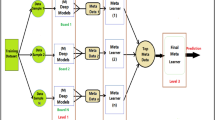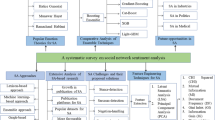Abstract
Ensemble learning is a powerful technique for combining multiple classifiers to achieve improved performance. However, the challenge of applying ensemble learning to dynamic and diverse data, such as text in sentiment analysis, has limited its effectiveness. In this paper, we propose a novel reinforcement learning-based method for integrating base learners in sentiment analysis. Our method modifies the influence of base learners on the ensemble output based on the problem space, without requiring prior knowledge of the input domain. This approach effectively manages the dynamic behavior of data to achieve greater efficiency and accuracy. Unlike similar methods, our approach eliminates the need for basic knowledge about the input domain. Our experimental results demonstrate the robust performance of the proposed method compared to traditional methods of base learner integration. The significant improvement in various evaluation criteria highlights the effectiveness of our method in handling diverse data behavior. Overall, our work contributes a novel reinforcement learning-based approach to improve the effectiveness of ensemble learning in sentiment analysis.











Similar content being viewed by others
References
Abasabadi S, Nematzadeh H, Motameni H, Akbari E (2021) Automatic ensemble feature selection using fast non-dominated sorting. Inf Syst. https://doi.org/10.1016/j.is.2021.101760
Ahmed M, Chen Q, Li Z (2020) Constructing domain-dependent sentiment dictionary for sentiment analysis. Neural Comput Appl. https://doi.org/10.1007/s00521-020-04824-8
Aram KY, Lam SS, Khasawneh MT (2023) Cost-sensitive max-margin feature selection for SVM using alternated sorting method genetic algorithm. Knowl-Based Syst 267:110421
Banik R, Biswas A (2023) Improving solar PV prediction performance with RF-catboost ensemble: a robust and complementary approach. Renewable Energy Focus. https://doi.org/10.1016/j.ref.2023.06.009
Barrachina-Muñoz S, Chiumento A, Bellalta B (2021) Stateless reinforcement learning for multi-agent systems: the case of spectrum allocation in dynamic channel bonding WLANs. In: 2021 Wireless Days (WD). pp 1–5
Basha SM, Rajput DS (2019) A roadmap towards implementing parallel aspect level sentiment analysis. Multimed Tools Appl 78:29463–29492
Beigi OM, Moattar MH (2021) Automatic construction of domain-specific sentiment lexicon for unsupervised domain adaptation and sentiment classification. Knowledge-Based Syst 213:106423
Chaturvedi I, Cambria E, Welsch RE, Herrera F (2018) Distinguishing between facts and opinions for sentiment analysis: Survey and challenges. Inf Fusion 44:65–77
Chen S, Devraj AM, Lu F, Busic A, Meyn S (2020) Zap Q-Learning with nonlinear function approximation. Adv Neural Inf Process Syst 33:16879–16890
Cherubin G (2019) Majority vote ensembles of conformal predictors. Mach Learn 108:475–488
Chiong R, Fan Z, Hu Z, et al (2018) A sentiment analysis-based machine learning approach for financial market prediction via news disclosures. In: Proceedings of the Genetic and Evolutionary Computation Conference Companion. pp 278–279
Coletta LFS, da Silva NFF, Hruschka ER, Hruschka ER (2014) Combining classification and clustering for tweet sentiment analysis. In: 2014 Brazilian Conference on Intelligent Systems. pp 210–215
Da’u A, Salim N, Rabiu I, Osman A (2020) Weighted aspect-based opinion mining using deep learning for recommender system. Expert Syst Appl 140:112871
Dang NC, Moreno-Garcia MN, la Prieta F (2020) Sentiment analysis based on deep learning: a comparative study. Electronics 9:483
Deegalla S, Walgama K et al (2022) Random subspace and random projection nearest neighbor ensembles for high dimensional data. Expert Syst Appl 191:116078
Dua D, Graff C, others (2017) UCI machine learning repository. http://archive.ics.uci.edu/ml. Accessed 12 Sept 2019
Frankel A (2019) Solution of the Generalized Linear Boltzmann Equation for Transport in Multidimensional Stochastic Media. arXiv Preprint. arXiv:190105874
Gargiulo F, Silvestri S, Ciampi M, De Pietro G (2019) Deep neural network for hierarchical extreme multi-label text classification. Appl Soft Comput 79:125–138
Hajewski J, Oliveira S (2019) Distributed SmSVM ensemble learning. In: INNS big data and deep learning conference. pp 7–16
Hernández-Fernández A, Mora E, Hernández MIV (2019) When a new technological product launching fails: a multi-method approach of facial recognition and E-WOM sentiment analysis. Physiol Behav 200:130–138
Huddar MG, Sannakki SS, Rajpurohit VS (2020) Multi-level feature optimization and multimodal contextual fusion for sentiment analysis and emotion classification. Comput Intell 36:861–881
Jiang J, Yu Y, Wang Z et al (2019) Ensemble super-resolution with a reference dataset. IEEE Trans Cybern 50:4694–4708
Ju BS, Kwag S, Lee S (2023) Performance-based drift prediction of reinforced concrete shear wall using bagging ensemble method. Nucl Eng Technol 55:2747–2756
Kaur RP, Kumar M, Jindal MK (2019) Newspaper text recognition of Gurumukhi script using random forest classifier. Multimed Tools Appl 79(11):7435–7448
Kaya B (2020) A hotel recommendation system based on customer location: a link prediction approach. Multimed Tools Appl 79:1745–1758
Kumar V, Pujari AK, Padmanabhan V et al (2018) Multi-label classification using hierarchical embedding. Expert Syst Appl 91:263–269
Kumar P, Gupta GP, Tripathi R (2021) A distributed ensemble design based intrusion detection system using fog computing to protect the internet of things networks. J Ambient Intell Human Comput 12(10):9555–9572
Li X, Wu P, Wang W (2020) Incorporating stock prices and news sentiments for stock market prediction: A case of Hong Kong. Inf Process Manag 57(5):102212
Liang D, Fan G, Lin G, et al (2019) Three-stream convolutional neural network with multi-task and ensemble learning for 3d action recognition. In: Proceedings of the IEEE/CVF Conference on Computer Vision and Pattern Recognition Workshops. p 0
Lin D, Matsumoto Y, Mihalcea R (2011) Proceedings of the 49th annual meeting of the association for computational linguistics: Human language technologies. Association for Computational Linguistics, Portland, Oregon, USA
López-Vázquez C, Hochsztain E (2019) Extended and updated tables for the Friedman rank test. Commun Stat Methods 48:268–281
Ma X, Zeng J, Peng L et al (2019) Modeling multi-aspects within one opinionated sentence simultaneously for aspect-level sentiment analysis. Futur Gener Comput Syst 93:304–311
Madasu A, Elango S (2020) Efficient feature selection techniques for sentiment analysis. Multimed Tools Appl 79:6313–6335
Menor-Flores M, Vega-Rodríguez MA (2023) Boosting-based ensemble of global network aligners for PPI network alignment. Expert Syst Appl 230:120671
Morente-Molinera JA, Kou G, Pang C et al (2019) An automatic procedure to create fuzzy ontologies from users’ opinions using sentiment analysis procedures and multi-granular fuzzy linguistic modelling methods. Inf Sci (ny) 476:222–238
Munezero M, Montero CS, Sutinen E, Pajunen J (2014) Are they different? Affect, feeling, emotion, sentiment, and opinion detection in text. IEEE Trans Affect Comput 5:101–111
Pang B, Lee L (2005) Seeing stars: exploiting class relationships for sentiment categorization with respect to rating scales. arXiv Preprint. arXiv:cs/0506075
Pang B, Lee L, Vaithyanathan S (2002) Thumbs up? Sentiment classification using machine learning techniques. arXiv preprint. arXiv:cs/0205070
Pham D-H, Le A-C (2018) Learning multiple layers of knowledge representation for aspect based sentiment analysis. Data Knowl Eng 114:26–39
Priya S, Uthra RA (2021) Retracted article: comprehensive analysis for class imbalance data with concept drift using ensemble based classification. J Ambient Intell Human Comput 12(5):4943–4956
Sagi O, Rokach L (2018) Ensemble learning: a survey. Wiley Interdiscip Rev Data Min Knowl Discov 8:e1249
Sánchez-Núñez P, de las Heras-Pedrosa C, Peláez JI (2020) Opinion mining and sentiment analysis in marketing communications: a science mapping analysis in web of science (1998--2018). Soc Sci 9:23
Savargiv M, Masoumi B, Keyvanpour MR (2021) A New random forest algorithm based on learning automata. Comput Intell Neurosci 2021:1–19. https://doi.org/10.1155/2021/5572781
Savargiv M, Masoumi B, Keyvanpour MR (2022) A new ensemble learning method based on learning automata. J Ambient Intell Humaniz Comput 13:3467–3482. https://doi.org/10.1007/s12652-020-01882-7
Sharma U, Datta RK, Pabreja K (2020) Sentiment analysis and prediction of election results 2018. In: Social Networking and Computational Intelligence. Springer, pp 727–739
Shaw R, Howley E, Barrett E (2021) Applying reinforcement learning towards automating energy efficient virtual machine consolidation in cloud data centers. Inf Syst. https://doi.org/10.1016/j.is.2021.101722
Sisodia DS, Bhandari S, Reddy NK, Pujahari A (2020) A comparative performance study of machine learning algorithms for sentiment analysis of movie viewers using open reviews. Perform Manag Integr Syst Appl Softw Eng. https://doi.org/10.1007/978-981-13-8253-6_10
Song W, Wen Z, Xiao Z, Park SC (2021) Semantics perception and refinement network for aspect-based sentiment analysis. Knowledge-Based Syst 214:106755
Sutton RS, Barto AG (2018) Reinforcement learning: an introduction. MIT press, Cambridge
Vidhya R, Vadivu G (2021) Retracted article: towards developing an ensemble based two-level studentclassification model (ESCM) using advanced learning patterns and analytics. J Ambient Intell Human Comput 12(7):7095–7105
Wang X, Yan WQ (2020) Cross-view gait recognition through ensemble learning. Neural Comput Appl 32:7275–7287
Werbin-Ofir H, Dery L, Shmueli E (2019) Beyond majority: label ranking ensembles based on voting rules. Expert Syst Appl 136:50–61
Wilhelmi F, Bellalta B, Cano C, Jonsson A (2017) Implications of decentralized Q-learning resource allocation in wireless networks. In: 2017 ieee 28th annual international symposium on personal, indoor, and mobile radio communications (pimrc). pp 1–5
Wu C, Xiong Q, Yi H et al (2021) Multiple-element joint detection for aspect-based sentiment analysis. Knowledge-Based Syst 223:107073
Zhou H, Song F (2015) Aspect-level sentiment analysis based on a generalized probabilistic topic and syntax model. In: The Twenty-Eighth International Flairs Conference
Author information
Authors and Affiliations
Corresponding author
Ethics declarations
Conflict of interests
The authors declare that they have no known competing financial interests or personal relationships that could have appeared to influence the work reported in this paper.
Rights and permissions
Springer Nature or its licensor (e.g. a society or other partner) holds exclusive rights to this article under a publishing agreement with the author(s) or other rightsholder(s); author self-archiving of the accepted manuscript version of this article is solely governed by the terms of such publishing agreement and applicable law.
About this article
Cite this article
Savargiv, M., Masoumi, B. & Keyvanpour, M.R. An Enhanced Ensemble Learning Method for Sentiment Analysis based on Q-learning. Iran J Sci Technol Trans Electr Eng (2024). https://doi.org/10.1007/s40998-024-00718-w
Received:
Accepted:
Published:
DOI: https://doi.org/10.1007/s40998-024-00718-w




